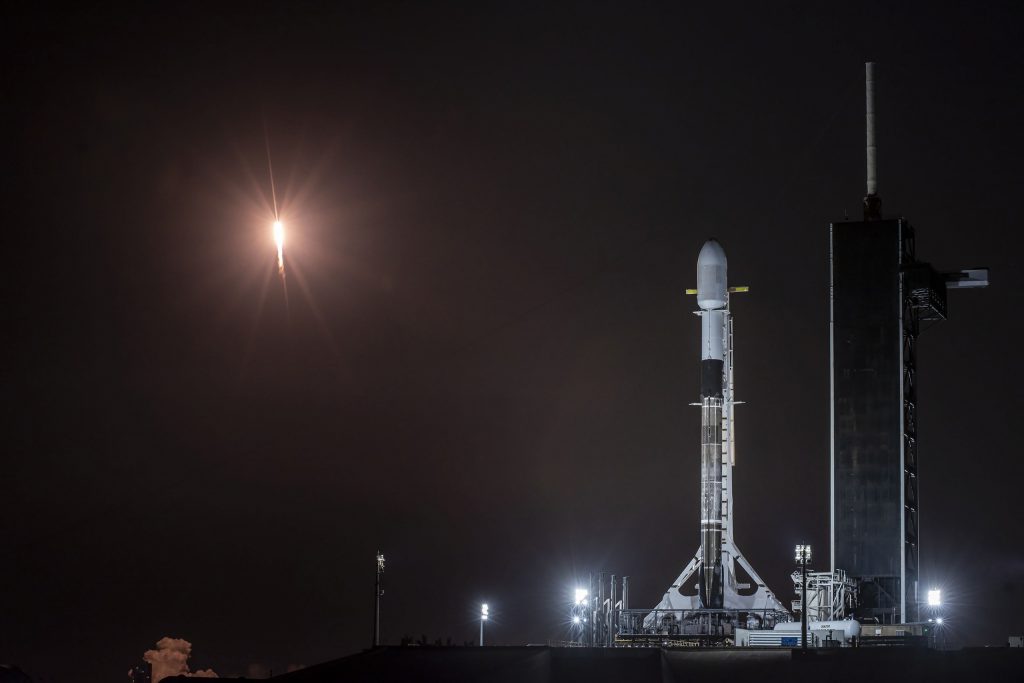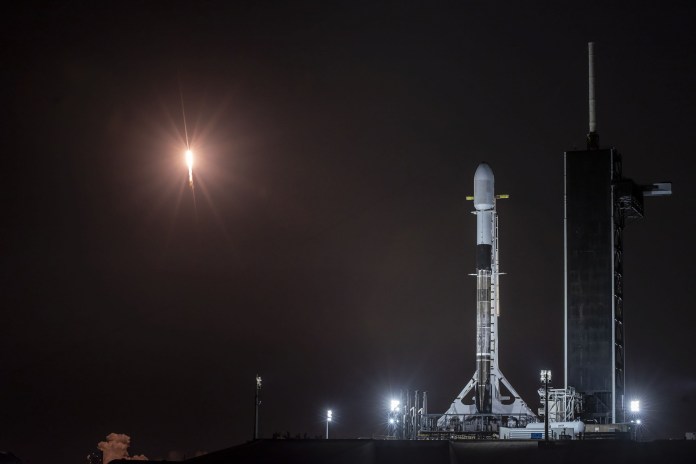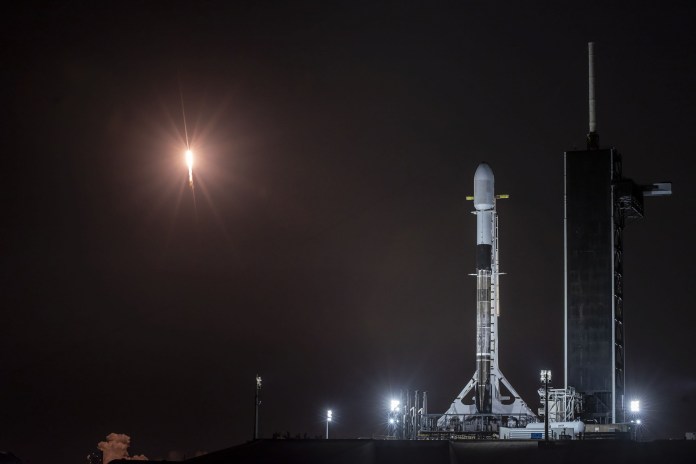
SpaceX set to launch long-delayed Starlink mission (Image Credit: SNN)

SpaceX is targeting 8:37 PM EST on Sunday, February 28 (01:37 UTC Monday, March 1) for the launch of the Starlink v1.0 L17 mission. Another batch of Starlink satellites will launch from historic LC-39A at the Kennedy Space Center aboard a flight proven Falcon 9 booster.
The 20th Starlink mission to date, this launch will loft another 60 satellites for SpaceX’s ever-growing Starlink satellite internet constellation. Officials at Cape Canaveral’s 45th Weather Squadron predict a 90% chance of acceptable conditions for launch—the primary concern being cumulus clouds and liftoff winds. Additionally, the 45th predicts a moderate risk of poor weather at the booster’s landing site about 633 kilometers downrange.
Due to technical, weather, and droneship-related delays, Starlink v1.0 L17 finds itself launching after the L18 and L19 missions. This is the first time that a Starlink mission will be launched “out-of-order,” but it is far from a first for spaceflight in general; the Space Shuttle program was frequently filled with seemingly confusing mission numbers.
After many delays, this mission was finally poised for launch on February 17, but was again postponed after booster B1059 failed to land after the Starlink v1.0 L19 mission.
During the 47th Spaceport Summit on February 23, SpaceX’s outgoing Vice President of Mission Assurance, Hans Koenigsmann, cited “heat damage” as the root cause of the unsuccessful recovery, but declined to disclose any further details.
Pre-Mission Preparations
On January 31 at 2:00 PM local time, Falcon 9 successfully completed a static fire test before launch, after an aborted static fire two days earlier.
Following Starlink v1.0 L19’s landing failure, and after the almost month-long launch delay after the previous static fire, SpaceX opted to complete another static fire test on February 24 at 3:00 AM local time. Several hours later, the company confirmed it was a success.
Static fire test complete – targeting Sunday, February 28 at 8:37 p.m. EST for launch of Starlink from LC-39A
— SpaceX (@SpaceX) February 24, 2021
With its payload already integrated—as is standard on Starlink missions—there was no need for Falcon 9 to roll back to its hangar and receive its payload prior to launch.
Countdown and Launch
Just 38 minutes before launch, SpaceX’s Launch Director will confirm that the Falcon 9 team is “go” for propellant loading, which will start three minutes later and continue until the final minutes of the countdown.
Initially, RP-1 kerosene will begin flowing into both stages of Falcon 9, while liquid oxygen loading into stage 1 also begins. Stage 2 liquid oxygen loading begins at T-16 minutes.
The nine Merlin 1D engines on Falcon 9’s first stage are thermally conditioned for ignition at T-7 minutes, a milestone known as engine chill. Falcon 9 enters startup at T-1 minute, when the onboard computers pressurize the propellant tanks to flight levels and conduct final pre-flight checks.
After lifting off from LC-39A, Falcon 9 will begin its pitch and roll maneuvers to target a 53 degree inclined orbit, flying northeast from Cape Canaveral.
Following stage separation at T+2:35, the first stage will reorient itself for landing, with a decelerating entry burn at T+6:41.
At 8 minutes and 28 seconds after launch, the booster will complete a final landing burn and attempt to touch down on the deck of Of Course I Still Love You. This is the first Falcon 9 landing attempt after a failed recovery on the v1.0 L19 mission broke a streak of 24 straight successful landings.
Falcon 9 B1051 returns to Port Canaveral aboard Just Read The Instructions following the Starlink v1.0 L16 mission – via Stephen Marr for NSF/L2
The second stage will utilize two burns of its Merlin vacuum engine to reach the targeted insertion orbit. After its first burn, the stage will coast for about 40 minutes. It will then perform a short, one second long burn to reach a roughly 250 by 290 kilometer orbit.
Deployment of all 60 Starlink satellites will take place at around 1 hour and 4 minutes after launch.
After deployment, the satellites will then take several weeks to reach their final 550 km circular orbits using their Krypton-powered ion thrusters.
Booster and Fairing Reuse
SpaceX selected veteran core B1049 for this launch: the oldest booster in the fleet. With a 73 day turnaround from its last mission, this booster will tie the fleet record for the most flights at eight—a record previously held by B1051, which will likely make its ninth flight sometime in March.
| B1049 Flight History | Launch Date | Turnaround Time |
| Telstar 18V | 10 September 2018 | N/A |
| Iridium-8 | 11 January 2019 | 123 days |
| Starlink v0.9 | 24 May 2019 | 133 days |
| Starlink v1.0 L2 | 7 January 2020 | 228 days |
| Starlink v1.0 L7 | 4 June 2020 | 149 days |
| Starlink v1.0 L10 | 18 August 2020 | 75 days |
| Starlink v1.0 L15 | 24 November 2020 | 98 days |
| Starlink v1.0 L17 | 28 February 2021 | 96 days |
This launch will also feature reused fairings—both halves from previous Starlink missions. One half will be making its third flight, and the other will be making the first ever fourth flight of a fairing half.
Around 45 minutes after launch, recovery ships GO Searcher and GO Navigator will attempt to scoop both halves from the water following their splashdown around 707 kilometers downrange from the launch site.
The dedicated fairing recovery vessels, GO Ms. Chief and GO Ms. Tree, have been undergoing maintenance work including removal of two each of their arms. SpaceX has experienced success with recovering fairings after splashdown, but a fairing half has not been caught since the Starlink v1.0 L13 mission in October 2020.
SpaceX practicing scooping fairings from the water on @NASASpaceflight Fleetcam! Watch now: https://t.co/E1uidiatGl pic.twitter.com/3QZZdsXAu2
— colin (@c_fletcher22) February 25, 2021
Starlink Updates and Future Manifest
SpaceX plans to launch the Starlink v1.0 L20 mission as soon as March 7 from SLC-40 at the Cape Canaveral Space Force Station. Further Starlink missions will likely continue throughout March and April until the next scheduled launch for an external customer, the NASA Crew-2 mission on April 20 from LC-39A.
As SpaceX continues to deploy more satellites, the expanding beta program has allowed more users to begin using Starlink for internet access. Elon Musk tweeted that improvements to speed and latency are expected later this year.
Speed will double to ~300Mb/s & latency will drop to ~20ms later this year
— Elon Musk (@elonmusk) February 22, 2021
Musk also mentioned that testing of those upgrades is underway, saying users “might see much higher download speeds on Starlink at times.”
The Starlink constellation is on track to provide connectivity to most of Earth by the end of 2021 and complete global coverage in 2022, followed by densifying coverage to complete the initial constellation.
(Lead photo via SpaceX)
The post SpaceX set to launch long-delayed Starlink mission appeared first on NASASpaceFlight.com.
– Advertisement –









